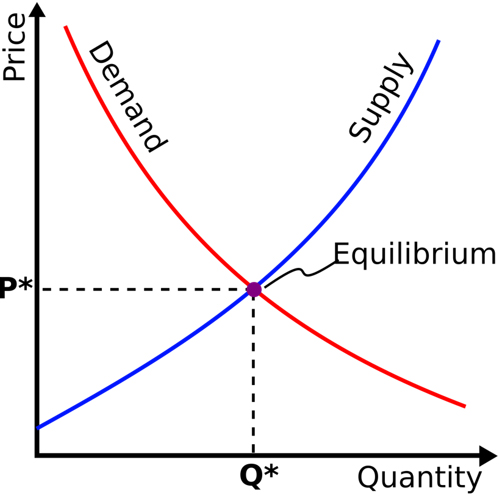HiSET Social Studies Study Guide: Economics
Economics questions will assess your knowledge and understanding of:
- Basic economic concepts
- How governments influence and interact with the economy
- Consumer economics
Types of Economic Systems
There are four basic types of economic systems. The term “economic decisions” refers to prices to sell goods and services, the construction of factories, and other economic factors.
| Type of economic system | How it works | Examples |
| Command economy | The government makes all economic decisions | The Soviet Union, Cuba |
| Market economy | Private businesses and entrepreneurs operate with little government oversight | The United States, The United Kingdom, Japan |
| Mixed economy | Combines aspects of a command and market economy | India, France |
| Traditional economy | Local economies where bartering for goods and services is typical | Indigenous tribes |
Government Financial Institutions
In the United States, the Department of the Treasury and the Federal Reserve play a significant role in the U.S. and world economies.
Department of the Treasury
Year founded: 1789
What it is: An executive department that reports to the president
What it does: The Treasury prints money, mints coins, manages the national debt, and collects all taxes.
The Federal Reserve
Year founded: 1913
What it is: An independent central bank run by the Board of Governors. The president appoints the governors, each of whom serves a 14-year term.
What it does: The Federal Reserve sets interest rates at which banks can borrow money (e.g. the discount rate), oversees regional Federal Reserve banks, and responds to economic crises.
The Basics of Economics: Supply, Demand, and Equilibrium
Below is one of the most basic charts in all of economics.

Source: SilverStar at English Wikipedia, CC BY-SA 3.0, via Wikimedia Commons
There are four main takeaways:
- The higher the price of a good or service, the lower the demand.
- The higher the supply of a good or service, the lower the demand.
- The lower the price of a good or service, the higher the demand.
- The lower the supply of a good or service, the higher the demand.
In other words, people want to buy things that are rare and/or cheap, and they don’t want to buy things that are expensive and/or readily available. Thankfully, there exists a happy medium known as equilibrium.
Equilibrium
Equilibrium is when the supply of a good or service exactly meets consumers’ demand for that good or service. Producers can maximize profit while consumers can maximize satisfaction.
Macroeconomics
Macroeconomics looks at economics as a whole, such as the function of and issues facing the national and world economies. There are many macroeconomics terms you should be familiar with going into the HiSET social studies test.
Business Cycle
The business cycle refers to the natural rise and fall of economic activity over time. It includes periods of expansion, when the economy grows and businesses thrive, and periods of contraction, when growth slows, unemployment rises, and spending declines. A strong boom phase may be marked by high consumer confidence and investment, while a bust could involve a recession or even a depression.
Deflation
Deflation is when prices go down due to either an increase in supply or a decrease in demand. Negative effects include unemployment.
Gross Domestic Product
Gross domestic product (GDP) measures the value of all goods and services an economy produces over a set time, usually one year. GDP growth from one year to another indicates a strong economy.
Inflation
Inflation is when prices rise, meaning people’s money is less valuable. Although strong economies expect some inflation, rapid inflation can lead to high interest rates and low exports.
Investment
Investment refers to buying an asset (e.g. stocks) that the buyer hopes will become more valuable over time. Nations can invest in many things, such as infrastructure and other nations’ debt.
Fiscal Policy
Fiscal policy refers to the government’s use of taxation and spending to influence the national and world economies.
Unemployment
Unemployment is the percentage of the working-age population not employed or actively searching for a job. A 5% or lower unemployment rate signifies a strong economy.
Microeconomics
Microeconomics looks at the economic decisions of individuals and companies. Here are the microeconomics terms you should be familiar with going into the HiSET social studies test.
Cartel
A cartel forms when two or more companies collaborate to raise profits. Most cartel practices, such as keeping prices high among competitors in the same field, are illegal.
Circular Flow
Circular flow refers to the flow of goods, services, and money among producers and consumers.
Elasticity
Elasticity refers to how much demand for or supply of a good or service changes over time. Some items (e.g. gasoline) have low demand elasticity because people always need them. High-elasticity items include luxury goods — things people stop buying in a recession.
Opportunity Cost
Opportunity cost is the value of the next best alternative you give up when you make a decision. It’s a key concept in economics that helps people understand the real cost of their choices — not just in money, but also in time, income, and experiences.
For example, imagine you’re working a full-time job earning $30,000 a year, but you decide to quit and attend college full time. The opportunity cost of going to college includes the $30,000 in income you’re no longer earning, plus any work experience you miss during those years. Of course, the benefit might be a better-paying job in the future — but the opportunity cost is what you give up right now by choosing school over work.

